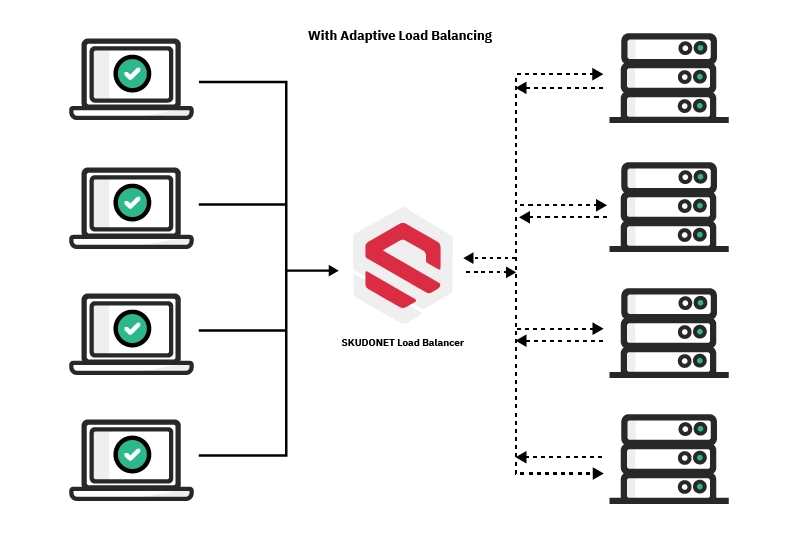In the ever-evolving landscape of network infrastructures, managing traffic efficiently is essential for ensuring optimal performance. Adaptive load balancing is one of the most advanced methods used to distribute network traffic across multiple servers or resources. But what is adaptive load balancing, and how does it function within network systems? Let’s break it down.
What is Adaptive Load Balancing?
Adaptive load balancing is a dynamic approach that continuously adjusts the distribution of traffic based on current conditions. Unlike traditional static methods, which evenly distribute traffic regardless of server performance, adaptive load balancing monitors real-time metrics such as server load, response times, and availability to make decisions. This ensures that traffic is routed to the best-performing server at any given moment.
In simpler terms, adaptive load balancing is like a traffic controller who constantly checks which routes are clear and directs cars accordingly, ensuring the fastest and most efficient path.
How Does Adaptive Load Balancing Work?
- Real-Time Monitoring: Adaptive load balancing starts by constantly monitoring server health and network traffic. It uses metrics such as CPU load, memory usage, response time, and bandwidth capacity to gauge the performance of each server.
- Dynamic Decision Making: Based on these metrics, the adaptive load balancer dynamically adjusts traffic flow, sending more requests to the best-performing servers. This prevents overloading a single server while ensuring all resources are utilized efficiently.
- Feedback Loops: Adaptive systems use feedback loops to refine decisions. If one server’s performance degrades, the system automatically redirects traffic to other servers in real-time, preventing slowdowns or failures.
- Adaptation: One of the key aspects of adaptive load balancing is its ability to adapt to changing network conditions. Whether there’s an unexpected spike in traffic or a server goes down, the system quickly reallocates resources and reroutes traffic to maintain service availability and performance.
Example of Adaptive Load Balancing in Action
Imagine a web application hosted on multiple servers across different locations. During regular hours, all servers handle traffic equally. However, during a peak traffic period, the adaptive load balancer detects that some servers are reaching their capacity. It dynamically shifts traffic away from the overloaded servers and redirects it to those that are underutilized or performing better. As traffic fluctuates, the system continues to monitor and adjust, ensuring the application remains fast and responsive.
This approach is particularly beneficial for applications with unpredictable traffic patterns or critical uptime requirements, such as e-commerce websites or financial services platforms.
The Difference Between Static and Adaptive Load Balancing
The main distinction between static and adaptive load balancing lies in how traffic is distributed. Static load balancing follows pre-defined rules without considering real-time conditions. It might evenly distribute requests across servers, but if one server is slower or experiencing issues, users may face delays or downtime.
On the other hand, adaptive load balancing is much more responsive. It evaluates real-time data, making it ideal for modern applications where traffic can fluctuate rapidly, and server performance may vary. This leads to improved resource utilization and enhanced user experiences.
Network Load Balancing Software and SKUDONET
Choosing the right network load balancing software is crucial for businesses that depend on high-performance networks. This is where SKUDONET comes into play. SKUDONET specializes in open-source load balancing solutions that incorporate adaptive load balancing to ensure seamless traffic distribution and maximum uptime for your systems.
With SKUDONET’s adaptive load balancing technology, businesses can enjoy:
- Real-time traffic monitoring: Keep track of server health and network performance.
- Dynamic scalability: Effortlessly adjust to changes in traffic demand.
- Optimized resource utilization: Distribute traffic based on server capacity and performance.
- Reliability: Ensure that traffic is always directed to the most available and best-performing servers.
By leveraging SKUDONET’s solutions, companies can significantly enhance their infrastructure’s performance and resilience, ensuring that their networks can handle even the most demanding traffic loads with ease.
Ready to optimize your network performance? Experience the full power of SKUDONET’s Enterprise Edition with advanced adaptive load balancing features. For a limited time, you can try it free for 30 days and see how it enhances traffic distribution, scalability, and uptime. Don’t miss this opportunity to elevate your infrastructure—Start your free trial today!




